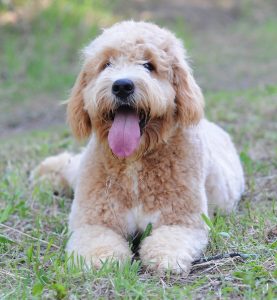 Goldendoodles are a cross between two of the top five smartest dogs in the world – a golden retriever and a poodle.
Goldendoodles are a cross between two of the top five smartest dogs in the world – a golden retriever and a poodle.
Goldendoodles are the ideal family dog, combining the clever, yet silly side of the poodle with the placid, loyal, and loving nature of the golden retriever.
Goldendoodles are low – to non-shedding, making them a popular choice for people with allergies.
Since I began breeding Goldendoodles in 1998, I have seen the breed go from almost non-existent, to one of the most popular family dogs in North America. Often described as “people in fur coats”, goldendoodles are full of charisma and thrive with human companionship. They are affectionate, playful, fun-loving, and intelligent dogs. Because they are so smart, they are easier to train than most breeds. They follow commands quickly and always want to please their owners. I’ve heard time and time again that our goldendoodles graduate top of their classes!
Whether this is your first dog, or you simply want an easygoing, playful dog, a goldendoodle would be an ideal choice. Goldendoodles are not a purebred dog, so they are not a registered breed.
The Golden Retriever
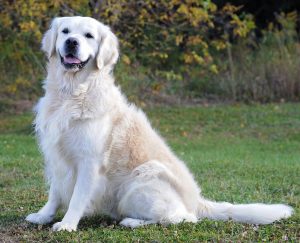 Golden retrievers are intelligent large-breed dogs, often used as gun dogs, search-and-rescue dogs, and detection dogs. They are often trained as disability assistance dogs because of their gentle and loving nature and their desire to be with people.
Golden retrievers are intelligent large-breed dogs, often used as gun dogs, search-and-rescue dogs, and detection dogs. They are often trained as disability assistance dogs because of their gentle and loving nature and their desire to be with people.
Golden retrievers love the water! It’s quite common for them to seek out water and go for a dip. Golden retrievers have a beautiful dense coat and are known to shed quite heavily.
The Poodle
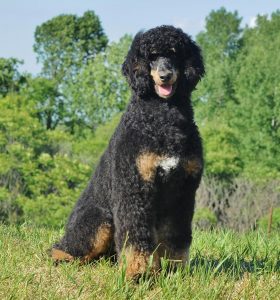 Poodles rank high on the canine intelligence scale and excel in obedience. Most people are aware that this lovely breed has a low – to non-shedding coat, making them a great choice for people with allergies. What people don’t realize is how lively and fun-loving poodles can be! They are the clowns of the dog world, and it’s no coincidence they were used in circus acts for centuries.
Poodles rank high on the canine intelligence scale and excel in obedience. Most people are aware that this lovely breed has a low – to non-shedding coat, making them a great choice for people with allergies. What people don’t realize is how lively and fun-loving poodles can be! They are the clowns of the dog world, and it’s no coincidence they were used in circus acts for centuries.
But the poodle is more than a clever show dog. They originated in Germany as hunting dogs, especially good at water retrieving. This breed doesn’t get nearly enough credit for being a hardy, intrepid dog that enjoys outdoor adventures.
Poodles are lively and playful, and have an assertive prance to their walk. They thrive in a busy household where there is plenty of attention to go around. Vigorous exercise and ongoing training are the keys to managing the poodle’s exuberance. If bored, poodles may find their way into mischief. They are also quick to sound an alert, and have earned a reputation for barking.
Poodles can be nervous and sensitive to stress, and are typically affected by eye, skin, and digestive diseases, as well as immune system diseases. The most common problems are bloat/torsion, thyroid issues, sebaceous adenitis, juvenile renal disease, hip dysplasia, and cancer.
Poodles come in three sizes and a wide variety of colours. They have a single layer of dense, curly fur that sheds minimally, but will mat without proper care.
Golden Retriever Meets Poodle…The Perfect Canine Companion
If a breeder does their due diligence in selecting the right parents, crossing purebred dogs of different breeds results in puppies that are healthier than either of their parents. This is because the two breeds are generally prone to different genetic problems. Hybrids such as goldendoodles are only likely to inherit a health problem that is common to both the poodle and the golden retriever – two breeds that share few common diseases. Goldendoodles, therefore, have what is referred to as “hybrid vigor,” and can be expected to live healthier, longer lives than their purebred parents.
A hybrid dog combines the traits and characteristics of its purebred parents; with careful, conscientious breeding, the resulting pups may end up with the best attributes of each. In the case of the goldendoodle, the blend of the 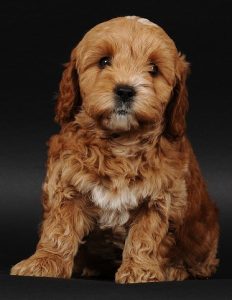 golden retriever and the poodle produces a smart, friendly, loving, social, playful dog. They tend to have the gentle, loving, and desire-to-please nature of the golden retriever, and the goofy liveliness and intelligence of the poodle. Like the golden retriever, they are gentle around children and the elderly, and because they love to work, they often make excellent therapy dogs. The goldendoodle is the go-to breed of choice when we select a dog to donate to a charitable organization.
golden retriever and the poodle produces a smart, friendly, loving, social, playful dog. They tend to have the gentle, loving, and desire-to-please nature of the golden retriever, and the goofy liveliness and intelligence of the poodle. Like the golden retriever, they are gentle around children and the elderly, and because they love to work, they often make excellent therapy dogs. The goldendoodle is the go-to breed of choice when we select a dog to donate to a charitable organization.
Most goldendoodles have a moderate activity level. They love to play, run, and hike with you, and will inherit the retriever’s affinity for the water and retrieving. They love toys and are always carrying around something in their mouths. When it’s time to relax, goldendoodles are happiest being by your side snuggled up with you. Most of them have little need for personal space and are often described as happy, goofy, smart, charming, curious, friendly, social, enthusiastic, cuddly, willing to please, and loving.
Goldendoodles vs. English Goldendoodles
English goldendoodles have a lighter coat, stockier build and are more laid-back. The retriever part of the English goldendoodle is an English golden retriever, which originates from Europe. English golden retrievers contain the stockier and more laid-back traits, and have a lighter coat in comparison to their North American counterpart, whom are typically darker in colour and more slender, with a more active personality.
We favour English golden retrievers within our breeding program, and have traveled across Europe acquiring some of the finest European breeding stock to incorporate into our lines.
Many breeders in the United States use field retrievers to produce their goldendoodles. These retrievers are bred for field work and tend to be very lanky and hyper. As a result they tend to produce hyper, lanky goldendoodles. This is a good example of why research is essential to finding a conscientious breeder.
Appearance and Coat
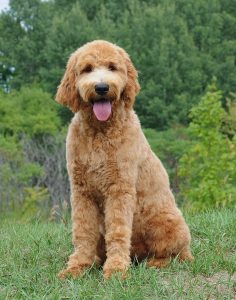 Most people think of goldendoodles as being golden in colour, but they can come in a variety of different colours. Their overall appearance combines a beautiful balance of the golden retriever and the poodle. Well-chosen parents tend to blend the traits of the poodle and the golden in a consistent way. Although some pups may lean more toward either the poodle’s slighter build or the golden retriever’s bulk, there is a common “look,” and a breeder can, to some extent, control that by studying the results of matching various pairs. In short, goldendoodles tend to look like shaggy teddy bears!
Most people think of goldendoodles as being golden in colour, but they can come in a variety of different colours. Their overall appearance combines a beautiful balance of the golden retriever and the poodle. Well-chosen parents tend to blend the traits of the poodle and the golden in a consistent way. Although some pups may lean more toward either the poodle’s slighter build or the golden retriever’s bulk, there is a common “look,” and a breeder can, to some extent, control that by studying the results of matching various pairs. In short, goldendoodles tend to look like shaggy teddy bears!
Breeders tend to develop their own style and look of dogs. A SwissRidge goldendoodle can easily be picked out of a crowd as there is a very distinct look and temperament to our dogs. The appearance of a SwissRidge goldendoodle is usually stocky with a well-built frame, beautiful head, and silky, soft, wavy coat.
Although every goldendoodle has a different coat, the majority have a wavy coat that sheds minimally, if at all. Breeders will evaluate the puppy at a few weeks old and can often tell the type of coat the dog will have, and can help match you to the best coat type for your situation.
Most people with allergies to dog dander are fine with a wavy-coated dog. It’s rare to see a goldendoodle with a straight coat. However, the straighter the coat, the more it sheds, making the dog less suitable for people with allergies. Goldendoodles with a curly coat are similar to the poodle and will not shed. Even people with severe allergies to dander typically do well with a curly-coated goldendoodle. Since there are no guarantees with coat type, a responsible breeder will give you time to interact with your puppy and see if you are allergic, allowing you time to return the pup if it is not working out.
If you are allergic to dog saliva, and your skin breaks out in hives when licked by a dog, you will most likely be allergic to all goldendoodles regardless of coat type. If you still want a dog, I would suggest a tiny goldendoodle as they produce less saliva.
The curlier the dog’s coat is, the harder it is to maintain. Since most goldendoodles shed very little, if at all, they need to be brushed regularly to prevent matting, and must be clipped every few months.
Size
Depending on the parents and their genetics, you can find goldendoodles in a wide range of sizes. Females are usually smaller than males.
A Standard Goldendoodle results from crossing a standard poodle with a golden retriever. They will generally be 50 lbs. and up, and around 23 to 29 inches at the shoulder. Most standards are in the 70 to 90 lb. range.
A Mini Goldendoodle results from crossing a miniature poodle with a golden retriever. They generally range from 25 to 49 lbs. and are 18 to 22 inches at the shoulder.
A Tiny Goldendoodle results from crossing a toy poodle with a mini goldendoodle. They range from 10 to 24 lbs and are about 12 to 17 inches at the shoulder.
In terms of temperament, mini and tiny goldendoodles may have a slightly higher energy level than the standard. Since we use calm poodles in our breeding program, we tend to produce docile goldendoodles, regardless of size.
Generations
F1 is a first generation cross in which the puppy is 50 percent golden retriever and 50 percent poodle. The F1 cross is considered the healthiest, as the parents are unlikely to contribute genes for common inheritable diseases.
F1b is a backcross in which a goldendoodle is bred with a poodle. The puppy is 25 percent golden and 75 percent poodle. F1b puppies are the most likely to be non-shedding and allergy-friendly. Some breeders have backcrossed a goldendoodle with a golden, which results in a dog with more of the golden retriever traits. I prefer not to breed this backcross as there is a greater likelihood of shedding.
F2 is a second generation cross in which an F1 goldendoodle is crossed with another F1 goldendoodle. If this is done for seven generations, a breeder could apply to register this dog as a purebred. The closer the generations come together, the more consistency there will be in the lines, but the genetic problems of the purebreds are more likely to reappear, and hybrid vigor diminishes. Some F2 puppies may have an improper coat instead of the fleecy softness we love in the doodles.
While goldendoodles vary in appearance and coat type, an experienced breeder will be able to give you an idea of what the pup will look like as an adult, based on what the parents have produced in the past and what traits they see in the pup.
Health and Lifespan
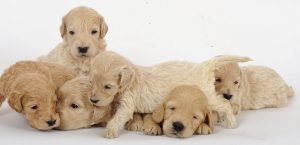 I have been breeding goldendoodles since 1998 and have found them to be healthy dogs with few health concerns. My dogs live an average of 10 to 16 years – a standard will typically have a shorter lifespan than a tiny.
I have been breeding goldendoodles since 1998 and have found them to be healthy dogs with few health concerns. My dogs live an average of 10 to 16 years – a standard will typically have a shorter lifespan than a tiny.
While goldendoodles tend to be healthier than their parent breeds, they can still be prone to conditions such as hip and elbow dysplasia and certain eye problems. Skin conditions, such as hot spots and allergies, are also seen in this mix, and like many other breeds, they may get cancer. Genetic testing can reduce the risk of many diseases. A reputable breeder will perform various tests and provide evidence of the successful results. It’s important for prospective buyers to understand that breeders invest a great deal of money upfront in finding healthy breeding stock and doing the required testing. This investment is usually reflected in the higher cost of the puppy for the buyer. A higher upfront cost will most likely reduce vet bills down the road.
Goldendoodle Mismatch
I believe the goldendoodle is a suitable dog for most people, with a few caveats:
- A low- to non-shedding coat means more time, effort, and money spent on grooming.
- Make sure you have plenty of time in your schedule to raise and train a new puppy. The hard work pays off in the end.
Practically anyone could raise a goldendoodle, and they are a very good choice for first-time dog owners and people with small children.
« Bernedoodles SwissRidge Doodles »
We wrote the first book on Bernedoodles
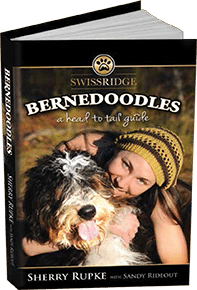
This comprehensive, easy-to-read and entertaining book covers everything you need to know about this amazing hybrid. Since Bernedoodles can vary significantly in size, build, coloring, and even personality, prospective owners need advice from someone who knows the breed inside out. Who better than the breeder who created them?
Pawsh Magazine – “… insightful tips for finding the right breed and puppy for your family dynamic.”
Thinking of adopting a SwissRidge™ puppy?
Often people will want one of my dogs because they are irresistibly adorable. Please take the time to consider if this breed is the right choice for you and your family. Click the link above to answer some questions to help you see if our doodles are the best match for you.
 Menu
Menu